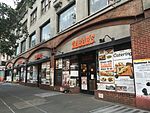Sawkill

The Sawkill or Saw-kill (the Dutch place-name for Saw Mill Creek) was the largest hydrological network on Manhattan island prior to the founding of the Dutch colony of New Netherland in 1624.: 557 This 44,980-foot-long (13,710 m) stream began "within four blocks of the Hudson River":: 95 A rill flowing east from the rocky ridge overlooking Bloomingdale Village, which rose near Ninth Avenue and 85th Street, flowed in a southerly direction through Manhattan Square, where it spread into a little pond, and then turned east, crossing Central Park to Fifth Avenue, receiving three tributaries within its limits, two from the north and one from the south. At 75th Street near Third Avenue it was joined by another stream. Near this junction the old Boston Post Road crossed it, and then from this point, the stream ran due east to its outlet near the foot of 75th Street emptying into the East River between two rocky points.: 132 Along its route the stream separated into two branches, with the name 'Sawkill' reserved for the southern arm of the creek.: 32 The name for the smaller, northern stream is undocumented, but is recorded by the Randel Map (1870) as entering the East River at 79th Street.: 32
Excerpt from the Wikipedia article Sawkill (License: CC BY-SA 3.0, Authors, Images).Sawkill
West 79th Street, New York Manhattan
Geographical coordinates (GPS) Address Nearby Places Show on map
Geographical coordinates (GPS)
| Latitude | Longitude |
|---|---|
| N 40.784982 ° | E -73.98266 ° |
Address
West 79th Street
West 79th Street
10024 New York, Manhattan
New York, United States
Open on Google Maps









